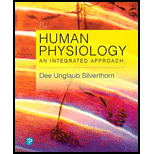
Human Physiology: An Integrated Approach (8th Edition)
8th Edition
ISBN: 9780134605197
Author: Dee Unglaub Silverthorn
Publisher: PEARSON
expand_more
expand_more
format_list_bulleted
Question
Chapter 4.3, Problem 9CC
Summary Introduction
Introduction: Proteins are the polypeptide chains that are made up of amino acids which are linked by peptide bonds. The complexity in the chain of amino acids determines the structure of a protein. There are four levels of protein structures, namely primary, secondary, tertiary, and quaternary.
Expert Solution & Answer
Want to see the full answer?
Check out a sample textbook solution
Students have asked these similar questions
Based on your results from the Mannitol Salt Agar (MSA) media, which of your bacteria were mannitol fermenters and which were not mannitol fermenters?
help tutor please
Q8. A researcher wants to study the effectiveness of a pill intended to reduce stomach heartburn in pregnant
women. The researcher chooses randomly 400 women to participate in this experiment for 9 months of their
pregnancy period. They all need to have the same diet. The researcher designs two groups of 200 participants:
One group take the real medication intended to reduce heartburn, while the other group take placebo
medication. In this study what are:
Independent variable:
Dependent variable:
Control variable:
Experimental group: "
Control group:
If the participants do not know who is consuming the real pills and who is consuming the sugar pills.
This study is
It happens that 40% of the participants do not find the treatment helpful and drop out after 6 months.
The researcher throws out the data from subjects that drop out. What type of bias is there in this study?
If the company who makes the medication funds this research, what type of bias might exist in this
research work?
Chapter 4 Solutions
Human Physiology: An Integrated Approach (8th Edition)
Ch. 4.1 - Which biomolecules always include nitrogen in...Ch. 4.1 - Prob. 2CCCh. 4.1 - What is the difference between potential energy...Ch. 4.1 - Prob. 4CCCh. 4.2 - Prob. 5CCCh. 4.2 - Prob. 6CCCh. 4.2 - Prob. 7CCCh. 4.3 - Prob. 8CCCh. 4.3 - Prob. 9CCCh. 4.3 - Prob. 10CC
Ch. 4.3 - Prob. 11CCCh. 4.4 - Name five ways in which cells regulate the...Ch. 4.4 - Prob. 13CCCh. 4.4 - Prob. 14CCCh. 4.4 - Match each component on the left to the...Ch. 4.4 - Prob. 16CCCh. 4.4 - How is the separation of mitochondria into two...Ch. 4.4 - Prob. 18CCCh. 4.4 - Prob. 19CCCh. 4.4 - Prob. 20CCCh. 4.4 - What does the name RNA polymerase tell you about...Ch. 4.4 - Explain in one or two sentences the relationship...Ch. 4.4 - Prob. 23CCCh. 4.4 - List three general types of posttranslational...Ch. 4.4 - Prob. 25CCCh. 4 - List the three basic forms of work and give a...Ch. 4 - Prob. 2RQCh. 4 - Prob. 3RQCh. 4 - Prob. 4RQCh. 4 - Prob. 5RQCh. 4 - Prob. 6RQCh. 4 - Match each definition in the left column with the...Ch. 4 - Prob. 8RQCh. 4 - Organic molecules that must be present in order...Ch. 4 - In an oxidation-reduction reaction, in which...Ch. 4 - Prob. 11RQCh. 4 - Prob. 12RQCh. 4 - Prob. 13RQCh. 4 - Metabolic regulation in which the last product of...Ch. 4 - Prob. 15RQCh. 4 - Prob. 16RQCh. 4 - Create maps using the following terms.Ch. 4 - Prob. 18RQCh. 4 - Prob. 19RQCh. 4 - Prob. 20RQCh. 4 - Prob. 21RQCh. 4 - Briefly describe the processes of transcription...Ch. 4 - On what molecule does the anticodon appear?...Ch. 4 - Is the energy of ATPs phosphate bond an example of...Ch. 4 - Prob. 25RQCh. 4 - Prob. 26RQCh. 4 - Prob. 27RQCh. 4 - Prob. 28RQ
Knowledge Booster
Similar questions
- What is behavioral adaptarrow_forward22. Which of the following mutant proteins is expected to have a dominant negative effect when over- expressed in normal cells? a. mutant PI3-kinase that lacks the SH2 domain but retains the kinase function b. mutant Grb2 protein that cannot bind to RTK c. mutant RTK that lacks the extracellular domain d. mutant PDK that has the PH domain but lost the kinase function e. all of the abovearrow_forwardWhat is the label ?arrow_forward
- Can you described the image? Can you explain the question as well their answer and how to get to an answer to an problem like this?arrow_forwardglg 112 mid unit assignment Identifying melting processesarrow_forwardGive only the mode of inheritance consistent with all three pedigrees and only two reasons that support this, nothing more, (it shouldn't take too long)arrow_forward
- Oarrow_forwardDescribe the principle of homeostasis.arrow_forwardExplain how the hormones of the glands listed below travel around the body to target organs and tissues : Pituitary gland Hypothalamus Thyroid Parathyroid Adrenal Pineal Pancreas(islets of langerhans) Gonads (testes and ovaries) Placentaarrow_forward
arrow_back_ios
SEE MORE QUESTIONS
arrow_forward_ios
Recommended textbooks for you
 Biology (MindTap Course List)BiologyISBN:9781337392938Author:Eldra Solomon, Charles Martin, Diana W. Martin, Linda R. BergPublisher:Cengage Learning
Biology (MindTap Course List)BiologyISBN:9781337392938Author:Eldra Solomon, Charles Martin, Diana W. Martin, Linda R. BergPublisher:Cengage Learning Human Heredity: Principles and Issues (MindTap Co...BiologyISBN:9781305251052Author:Michael CummingsPublisher:Cengage Learning
Human Heredity: Principles and Issues (MindTap Co...BiologyISBN:9781305251052Author:Michael CummingsPublisher:Cengage Learning


Biology (MindTap Course List)
Biology
ISBN:9781337392938
Author:Eldra Solomon, Charles Martin, Diana W. Martin, Linda R. Berg
Publisher:Cengage Learning




Human Heredity: Principles and Issues (MindTap Co...
Biology
ISBN:9781305251052
Author:Michael Cummings
Publisher:Cengage Learning